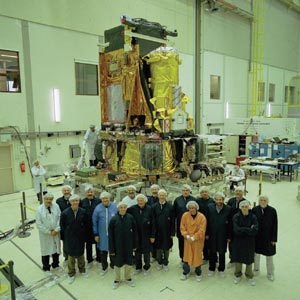
The launch of the International Gamma-Ray Astrophysics Laboratory (INTEGRAL) is scheduled for 17 October. Gamma-ray astronomy explores the most energetic phenomena in the universe and addresses some of the most fundamental problems in physics and astrophysics. INTEGRAL will study hard X-ray and gamma-ray sources in the energy range of 15 keV to 10 MeV.
The launch is awaited with much anticipation. Many of the sources discovered by INTEGRAL’s predecessor, the Compton Gamma-Ray Observatory, remain unidentified. Indeed, the new instruments on board INTEGRAL will provide a big leap forward in both fine spectroscopy and imaging, enabling sources to be positioned accurately.
In particular, INTEGRAL will be used to study the radiation from compact objects such as neutron stars and black holes, and to help pinpoint the origins of gamma-ray bursts. The mechanisms fuelling gamma-ray bursts are still unknown, and they are by far the most powerful events known to occur since the Big Bang itself.
Indeed, some of the universe’s most energetic processes are the least understood, another example being the highly relativistic jets seen streaming from active galactic nuclei. Gamma-ray observations are essential for understanding the particle interactions and the acceleration processes taking place.
INTEGRAL will also map the diffuse gamma-ray background and, on a smaller scale, galactic structure and the elements making up the interstellar medium. The spectrometer will be used to study the production of elements by stellar nucleosynthesis by observing, among other things, the radioactive elements ejected into space by supernovae.
Of course, astronomers also hope for many unexpected discoveries, mirroring the huge leap forward made since the launch of new X-ray satellites, Chandra and XMM Newton.
The countries participating in INTEGRAL are Switzerland, Germany, Denmark, France, Italy, Ireland, Poland and the US. The science data centre is located in Versoix, Switzerland.
Looking further into the future, the Gamma-ray Large Area Space Telescope (GLAST) is due for launch in 2006. Funded by the US, France, Germany, Italy, Japan and Sweden, its energy range will be from 10 keV to 300 GeV. Several ground-based gamma-ray facilities are also under construction.







